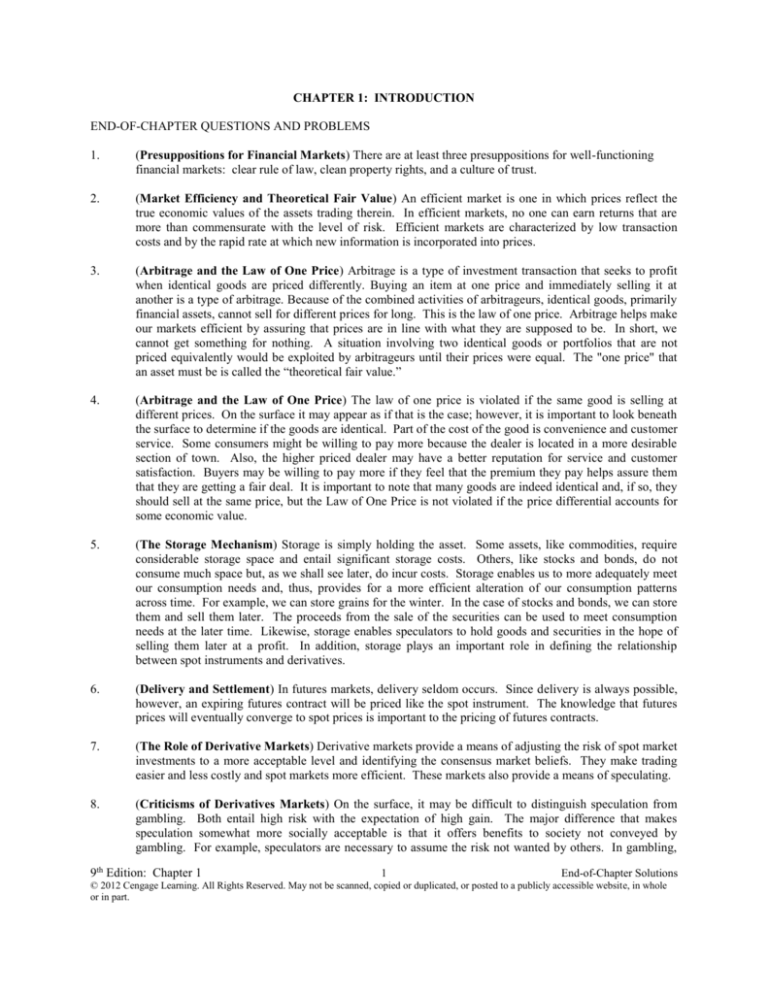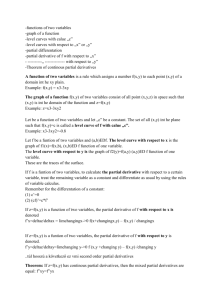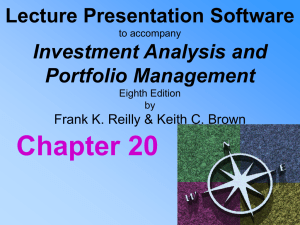
CHAPTER 1: INTRODUCTION
END-OF-CHAPTER QUESTIONS AND PROBLEMS
1.
(Presuppositions for Financial Markets) There are at least three presuppositions for well-functioning
financial markets: clear rule of law, clean property rights, and a culture of trust.
2.
(Market Efficiency and Theoretical Fair Value) An efficient market is one in which prices reflect the
true economic values of the assets trading therein. In efficient markets, no one can earn returns that are
more than commensurate with the level of risk. Efficient markets are characterized by low transaction
costs and by the rapid rate at which new information is incorporated into prices.
3.
(Arbitrage and the Law of One Price) Arbitrage is a type of investment transaction that seeks to profit
when identical goods are priced differently. Buying an item at one price and immediately selling it at
another is a type of arbitrage. Because of the combined activities of arbitrageurs, identical goods, primarily
financial assets, cannot sell for different prices for long. This is the law of one price. Arbitrage helps make
our markets efficient by assuring that prices are in line with what they are supposed to be. In short, we
cannot get something for nothing. A situation involving two identical goods or portfolios that are not
priced equivalently would be exploited by arbitrageurs until their prices were equal. The "one price" that
an asset must be is called the “theoretical fair value.”
4.
(Arbitrage and the Law of One Price) The law of one price is violated if the same good is selling at
different prices. On the surface it may appear as if that is the case; however, it is important to look beneath
the surface to determine if the goods are identical. Part of the cost of the good is convenience and customer
service. Some consumers might be willing to pay more because the dealer is located in a more desirable
section of town. Also, the higher priced dealer may have a better reputation for service and customer
satisfaction. Buyers may be willing to pay more if they feel that the premium they pay helps assure them
that they are getting a fair deal. It is important to note that many goods are indeed identical and, if so, they
should sell at the same price, but the Law of One Price is not violated if the price differential accounts for
some economic value.
5.
(The Storage Mechanism) Storage is simply holding the asset. Some assets, like commodities, require
considerable storage space and entail significant storage costs. Others, like stocks and bonds, do not
consume much space but, as we shall see later, do incur costs. Storage enables us to more adequately meet
our consumption needs and, thus, provides for a more efficient alteration of our consumption patterns
across time. For example, we can store grains for the winter. In the case of stocks and bonds, we can store
them and sell them later. The proceeds from the sale of the securities can be used to meet consumption
needs at the later time. Likewise, storage enables speculators to hold goods and securities in the hope of
selling them later at a profit. In addition, storage plays an important role in defining the relationship
between spot instruments and derivatives.
6.
(Delivery and Settlement) In futures markets, delivery seldom occurs. Since delivery is always possible,
however, an expiring futures contract will be priced like the spot instrument. The knowledge that futures
prices will eventually converge to spot prices is important to the pricing of futures contracts.
7.
(The Role of Derivative Markets) Derivative markets provide a means of adjusting the risk of spot market
investments to a more acceptable level and identifying the consensus market beliefs. They make trading
easier and less costly and spot markets more efficient. These markets also provide a means of speculating.
8.
(Criticisms of Derivatives Markets) On the surface, it may be difficult to distinguish speculation from
gambling. Both entail high risk with the expectation of high gain. The major difference that makes
speculation somewhat more socially acceptable is that it offers benefits to society not conveyed by
gambling. For example, speculators are necessary to assume the risk not wanted by others. In gambling,
9th Edition: Chapter 1
1
End-of-Chapter Solutions
© 2012 Cengage Learning. All Rights Reserved. May not be scanned, copied or duplicated, or posted to a publicly accessible website, in whole
or in part.
there is no risk being hedged. Gamblers simply accept risk without there being a concomitant reduction in
someone else's risk.
9.
(Misuses of Derivatives) Derivatives can be misused by speculating when one should be hedging, by not
having acquired the requisite knowledge to use them properly by acting irresponsibly when using
derivatives such as by being overly confident of one’s ability to forecast the direction of the market.
10.
(The Role of Derivative Markets) The existence of derivative markets in the United States economy and
indeed throughout most modern countries of the world undoubtedly leads to a much higher degree of
market efficiency. Derivatives facilitate the activities of individual arbitrageurs so that unequal prices of
identical goods are arbitraged until they are equal. Because of the large number of arbitrageurs, this is a
quick and efficient process. Arbitrage on this large a scale makes markets less capable of being
manipulated, less costly to trade in, and therefore more attractive to investors. (The opportunity to hedge
also makes the markets more attractive to investors in managing risk.) This is not to say that an economy
without derivative markets would be inefficient, but it would not have the advantage of this arbitrage on a
large scale.
It is important to note that the derivative markets do not necessarily make the U.S. or world economy any
larger or wealthier. The basic wealth, expected returns, and risks of the economy would be about the same
without these markets. Derivatives simply create lower cost opportunities for investors to align their risks
at more satisfactory levels. This may not necessarily make them wealthier, but to the extent that it makes
them more satisfied with their positions, it serves a valuable purpose.
11.
(Return and Risk) Return is the numerical measure of investment performance. There are two main
measures of return, dollar return and percentage return. Dollar return measures investment performance as
total dollar profit or loss. For example, the dollar return for stocks is the dollar profit from the change in
stock price plus any cash dividends paid. It represents the absolute performance. Percentage return
measures investment performance per dollar invested. It represents the percentage increase in the investor’s
wealth that results from making the investment. In the case of stocks, the return is the percentage change in
price plus the dividend yield. The concept of return also applies to options, but, as we shall see later, the
definition of the return on a futures or forward contract is somewhat unclear.
12.
(Repurchase Agreements) A repurchase agreement (known as repos) is a legal contract between a seller
and a buyer, the seller agrees to sell a specified asset to the buyer currently as well as buy it back usually at
a specified time in the future at an agreed future price. The seller is effectively borrowing money from the
buyer at an implied interest rate. Typically, repos involve low risk securities, such as U. S. Treasury bills.
Repos are useful because they provide a great deal of flexibility to both the borrower and lender.
Derivatives traders often need to be able to borrow and lend money in the most cost-effective manner
possible. Repos are often a very low cost way of borrowing money, particularly if the firm holds
government securities. Repos are a way to earn interest on short-term funds with minimal risk (for buyers)
and repos are a way to borrow for short-term needs at a relatively low cost (for sellers).
13.
(Derivative Markets and Instruments) An option is a contract between two parties—a buyer and a
seller—that gives the buyer the right, but not the obligation, to purchase or sell something at a later
date at a price agreed upon today. The option buyer pays the seller a sum of money called the price
or premium. The option seller stands ready to sell or buy according to the contract terms if and when
the buyer so desires. An option to buy something is referred to as a call; an option to sell something is
called a put.
A forward contract is a contract between two parties—a buyer and a seller—to purchase or sell
something at a later date at a price agreed upon today. A forward contract sounds a lot like an option,
but an option carries the right, not the obligation, to go through with the transaction. If the price of
9th Edition: Chapter 1
2
End-of-Chapter Solutions
© 2012 Cengage Learning. All Rights Reserved. May not be scanned, copied or duplicated, or posted to a publicly accessible website, in whole
or in part.
the underlying good changes, the option holder may decide to forgo buying or selling at the fixed
price. On the other hand, the two parties in a forward contract incur the obligation to ultimately buy
and sell the good.
14.
(The Underlying Asset) Because all derivatives are based on the random performance of something,
the word “derivative” is appropriate. The derivative derives its value from the performance of
something else. That “something else” is often referred to as the underlying asset. The term
underlying asset, however, is somewhat confusing and misleading. For instance, the underlying asset
might be a stock, bond, currency, or commodity, all of which are assets. However, the underlying
“asset” might also be some other random element such as the weather, which is not an asset. It might
even be another derivative, such as a futures contract or an option.
15.
(Swaps and Other Derivatives) A swap would allow the two parties to exchange cash flows. A firm may
be receiving cash from one investment but would prefer another type of investment in which the cash flows
are different. The party contacts a swap dealer who takes the opposite side of the transaction. Thus, the firm
and the dealer, in effect, swap cash flow streams.
16.
(Risk Preference) The expected outcome of this opportunity is ($10 + $0 - $1) / 3 = $3. As a risk neutral
individual (one who is indifferent to the risk inherent in the opportunity), you would be willing to pay $3 to
take the risk of playing the game. If you were instead risk averse, you would be willing only to pay some
amount less than $3. If you were risk seeking, you would be willing to pay some amount more than $3.
17.
(Short Selling) If an individual anticipates the price of a stock falling, he can attempt to capture a profit by
selling short. He would first borrow the stock from a broker and sell that stock in the marketplace. If the
price of the stock then indeed fell, he would buy back the stock at a lower price. This would allow him to
capture a profit and repay the shares to the broker. Short selling creates a liability in that the short seller is
obligated to someday buy back the stock and return it to the broker; however, the short seller does not
know how much he will have to pay to buy back the shares.
18.
(Operational Advantages) First, derivative markets entail lower transaction costs. Second, derivative
markets often have greater liquidity than spot markets. And third, derivative markets allow investors to sell
short in an easier manner.
19.
(Derivatives and Ethics) Codes of ethics perform a vital role in governing the behavior of finance
professionals. Every major finance practitioner association has adopted a code of ethics as well as standards
of professional conduct. These moral principles provide essential guidance to professionals facing difficult
and complex situations that often have economic interests that conflict. Before entering a specific
profession, it is important to fully understand existing normative ethics and consider your own personal
ability to abide within the expectations engendered by these codes of ethics.
9th Edition: Chapter 1
3
End-of-Chapter Solutions
© 2012 Cengage Learning. All Rights Reserved. May not be scanned, copied or duplicated, or posted to a publicly accessible website, in whole
or in part.












